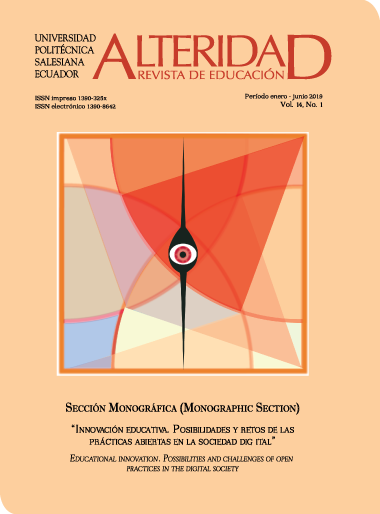ICTs and Media Arts: The new digital age in the inclusive school
Main Article Content
Abstract
The paper corresponds an educational experience about the impact of the pedagogical practices of digital media in the classroom. In this main objective is to understand the relation between the complementary subject (Art Education and Technology Education) and the interdisciplinary methodology. As well as a new methodology for technological education in media arts. In this context of the inclusive school, the role of educational innovation assumes great importance, however, in order to improve and merge with a modernized model between teaching duo, digital content and inclusive students in the virtual classroom. As the results of the activities carried out in the different workshops of: Stop Motion Animation for primary education, and Video Art for secondary education. In both workshops, those that correspond to the simple of the plan of complementary subject in different artistic-technological activities, depending on the level of schooling. Therefore, a true educational change for the whole of society and the inclusive school. One of the great challenges of the future in the educational task in the classroom, which contributes to satisfy the needs of new educational opportunities both the professionals and the teaching leadership, sharing and promoting with collaborative work towards a new alternative method of strategic learning and the participation of students within the virtual classroom.
Article Details
Section
Central Theme
Authorship: The list of authors signing must include only those people who have contributed intellectually to the development of the work. Collaboration in the collection of data is not, by itself, a sufficient criterion of authorship. "Alteridad" declines any responsibility for possible conflicts arising from the authorship of the works that are published.
Copyright: The Salesian Polytechnic University preserves the copyrights of the published articles, and favors and allows their reuse under the Creative Commons Attribution-NonCommercial-ShareAlike 3.0 Ecuador license. They may be copied, used, disseminated, transmitted and publicly displayed, provided that: i) the authorship and the original source of their publication (journal, editorial and work URL) are cited; (Ii) are not used for commercial purposes; Iii) mention the existence and specifications of this license.
Copyright: The Salesian Polytechnic University preserves the copyrights of the published articles, and favors and allows their reuse under the Creative Commons Attribution-NonCommercial-ShareAlike 3.0 Ecuador license. They may be copied, used, disseminated, transmitted and publicly displayed, provided that: i) the authorship and the original source of their publication (journal, editorial and work URL) are cited; (Ii) are not used for commercial purposes; Iii) mention the existence and specifications of this license.

